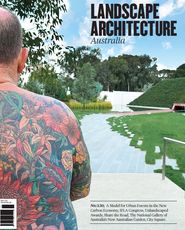
Mandy Rounsefell, AILA National President.
This past summer of 2011 will stay long in our antipodean memories as the “summer of natural disasters.” From relentless rain leading to floods to bushfires, cyclones and now, as I write, the aftermath of a major earthquake, there is not much we haven’t experienced in the first two months of this year. And if not affected directly, we all know someone who was. Such is the nature of our island communities.
Sometimes it feels like nature smiled cruelly, leant over and prodded us with a “wake-up” stick once again, just to test if we had been listening to the warning signs, to check if we really were as prepared and sophisticated a society as we had claimed to be. Natural disasters are great “levellers” – in the face of adversity we have proved over and again that the basic elements of human nature and generosity are what get us through these hard times.
The role of technology in these unfolding disasters has been a double-edged sword. The ease and speed of the way information was able to be transmitted around the world, even from loved ones trapped in rubble communicating while awaiting rescue, has been incredible. Social media has been heavily used as a tool to find people. And by the same token, some of those very systems we relied on to warn and save us in emergency failed spectacularly.
The website Brisbanites were meant to turn to for guidance and information during a flood emergency crashed for the duration. Even the local radio’s emergency broadcasts needed to be redirected as transmission tower batteries ran low on power after two days. Christchurch’s phone system and communications infrastructure were unable to cope. Meanwhile the Bureau of Meteorology’s website was swamped by those searching for information, with macro and micro analysis of every cloud pattern, rainfall, heat and wind analysis able to be viewed in spectacular multicoloured maps, tables and charts.
But even the stark text warnings and multicoloured rain bands on the BOM website radar loops couldn’t save people from disaster. Nature remains unpredictable and, if given human qualities, can be merciless. Sweltering heatwaves hit New South Wales and Queensland’s turn came yet again, with Cyclone Yasi’s power illustrated in scary yet captivating satellite images and photos. These images of the aftermath showed the cyclone’s trail across the continent as it fanned the flames of the devastating bushfires in the west and finally, weeks later, quietly gave birth to renewed desert life in the lowest lying part of the continent.
So now that Mother Nature has given us a rather rude wake-up call, what are we going to learn from this? As one of the most adaptive species on earth we have once again shown our resilience to natural disaster, but the question remains, how much of this did we bring upon ourselves? If we insist on living in cyclone-, flood- and fire-prone areas do we then force expensive planning and engineering solutions, or do we just ensure we have earlier, clearer and more understandable information on possible risks to avoid the loss of life and accept the loss of property? One thing is for certain – we can’t engineer solutions for all risks. We have marketed ourselves and attracted people to our economies based on the natural features where we live. Our collective memories grow dim with time when thinking of previous events. And yet we live on a massive flood plain and are surprised when it floods. We live in a sclerophyll forest and don’t have a fire plan or exit strategy.
As people put their lives back together in the coming months and years, the design, development and authority communities will need to undertake a great deal of soul searching and discussion around planning, engineering and urban design responses to prepare us better in the future. Disaster risk versus cost will be debated until we are blue in the face. We need to ask ourselves some basic questions – like what haven’t we learnt in Western Australia since Victoria’s bushfire experiences a few years ago? What is an acceptable building-floor level in flood-prone areas, and should the standards be reviewed? I know I’m not the only one who was amazed at the number of new roofs and swanky riverfront apartment “islands” during the floods. Many people who thought they were safe because they were above the Brisbane 1974 flood line may well ask why their local planning policies allowed them to build in some areas, or why at a minimum they didn’t allow for an indication of the extent of potential inundation in a worst-case scenario of a culmination of events – in Brisbane’s case a major rain event, a full dam and a high tide on the city’s tidal river.
While preparing for future events and the likelihood of more extreme events in a future changed climate, we need to be careful that any adaptation strategies are carefully integrated into the whole. Most strategies will start as planning and engineering solutions – lines on a plan, retreat strategies or higher revetment walls, reinforced buildings and structures. I, for one, don’t want to be “walled in,” surrounded by engineering solutions that reduce connectivity and personal safety and overtly affect the use of our cities and public realms. We need to balance our fear of potential disaster we can’t fully control with the need to work closely on these hard engineering solutions to maintain the vitality, functionality and beauty of the urban and open space environments around us.
Source

Discussion
Published online: 23 Sep 2011
Words:
Mandy Rounsefell
Issue
Landscape Architecture Australia, May 2011














